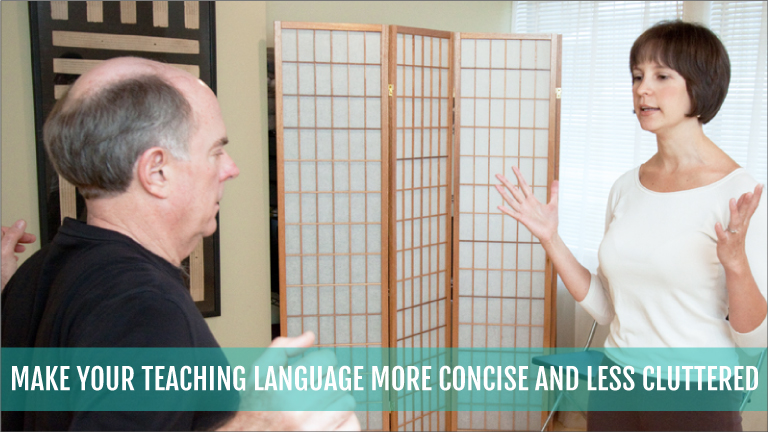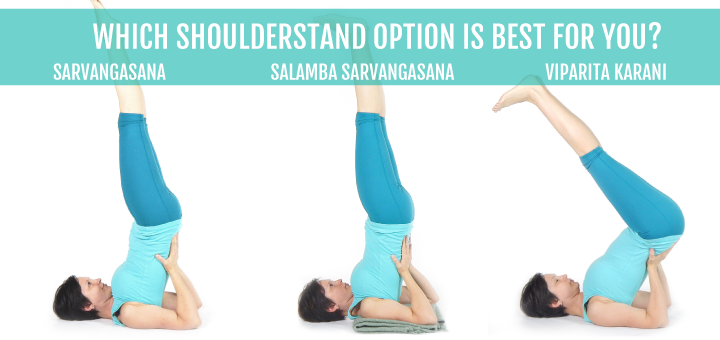Nine phrases to purge from your yoga instruction

One of my friends had recently reported on her experience in a yoga class: “The teacher was really nice, but she kept calling us “folks” literally in every sentence and sometimes twice in one sentence. It was really distracting.” Oh, the speech clutter… I remember in my yoga teacher training, we were asked to record ourselves teaching and then analyze the recording – a very useful exercise. I was horrified when I heard myself on tape – I had no idea it sounded that way. For the past ten years, I’ve been working on making my teaching language clearer, concise, and less cluttered and helping my teacher trainees do the same.
Here is the list of the most common “language offenders” that I come across:
1. “Words-parasites” (an actual linguistic term) – “like,” “folks,” “something like that,” etc. Those words/phrases do not serve any purpose and are unnecessary in a yoga class. You may end up sounding like a stereotypical chatty teenage girl, not the experienced professional that you are. I often find that teachers use those words to fill up space while they are thinking about what comes next; if that’s the case, there is no need to say anything. Sometimes, it’s just a habit that needs to be overcome.
2. “I want you to …” is quite common in yoga classes. Using it makes an impression that the practice is about you, the teacher, not about your student. It’s as if they are doing it for you. Our goal is to empower our students and give them a sense of ownership of their practice, not take it away.
3. “Breathe into your right big toe”—We often ask our students to “breathe into” body parts where physiologically, breath has no business going. If by that you mean “bring your attention to your right big toe,” say that. If you mean “AS IF you are breathing into your right big toe,” say that. Keeping your instructions clear will help prevent your students from thinking, “Ha?”
4. “Expand your thighbones like rainbows radiating outwards” and other flowery language. There is time and place for that, for example, during meditation or relaxation, if that’s your style. When you instruct movement, it’s best to be more precise. What are you asking them to do exactly? Then, the students are clear about what’s expected of them. In my experience, many students perceive this kind of language as “fluff” and tolerate it as a necessary evil. And that is not the response we are after.
5. “Allow” is a very common word one hears in a yoga class. It always makes me wonder – who is in charge? Who is doing this practice? You do not technically “allow your arm to lift;” it will not do it on its own; you have to do it. Action words like “lift, raise, put, etc.” make your students feel capable and in charge, while “allow” creates an impression of being pulled by some mysterious force. There is a place for “allow,” of course. For example, in Savasana, it is perfectly appropriate to say, “Allow your belly to expand naturally on the inhalation,” because here you are letting go of the effort and allowing things to happen on their own.
6. “Let’s just …” When you say that, it sounds as if you are apologizing or pleading with your students. In a yoga class, you are the authority figure, and you need to project confidence. Otherwise, your students will doubt your competence. It is similar to saying to my toddler: “Let’s just wash your hands before dinner if you don’t mind.” Don’t plead. Tell them directly what you expect them to do.
7. Saying “piriformis” and pointing to quadratus lumborum. Name the muscles only if you are confident in your knowledge. If you are not clear yourself, don’t say anything. We do not want to spread misinformation, and you never know who is in your class today – a doctor, a massage therapist, or another yoga teacher; they will catch incorrect information immediately. I have a student who refers to any part of her hip as a “hip flexor.” It’s an ongoing joke between the two of us, but it wouldn’t be funny if it were coming from a yoga teacher.
8. Yoga voice. At the beginning of my teaching career, I remember myself adopting a “teaching voice” – slightly higher pitched, different modulation, flowing more like a song. When I heard myself on tape, I realized that it sounded completely fake. This is what I thought a yoga teacher should sound like. Be yourself. Talk how you normally talk. You don’t need to assume a different persona when you teach, it’s best to be authentic in your instructions and your presentation.
9. Talking your student’s ear off. As yoga teachers, we’ve learned a lot, and we want to share our knowledge, experience, and suggestions. It’s all understandable. Often, it turns out to be too much. If a teacher talks non-stop during class, where is the space for a student to connect to her own experience? The student will either feel overwhelmed or tune you out. During Savasana, it’s best to stop talking unless you are doing a guided relaxation. Give them a chance to absorb and integrate. And if someone asks a question at the end of the class, it’s best to be brief and concise. I once observed a yoga teacher give a very lengthy answer to a student’s question, and it looked almost comical – the student looked uncomfortable and was trying to get away while the teacher held on to the student’s sleeve and kept on talking. It would be funny if it weren’t so sad.
Language is the most powerful tool for a yoga teacher. What we say to our students before, during, and after the class matters. Keeping the language simple, clean, and concise helps the student cultivate attention and fosters mental clarity.
Have you ever recorded yourself teaching? What was your impression? What other language mishaps did you observe in yourself and other teachers that we can all learn from?











Thanks for the reminder, Olga. I definitely learned from you to be conscious of unnecessary gibberish in class, I am sure my students appreciate it!
Thanks so much for this article; it made me laugh! Such a great reminder! How a teacher speaks determines whether or not I’m going to take a class from them again. I’m not that picky, but it’s important. I should definitely record myself one of these days, although it scares me a little 🙂
Thank you, Jessica! Fear not – if you do record yourself you might find out that your language is as clear as it can be! And ultimately isn’t it better to know then to wonder? 🙂
So useful. Thank you. This will be the topic of our teacher training discussion this weekend.
Much gratitude Olga!